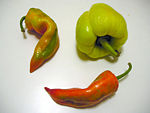Paprika
2008/9 Schools Wikipedia Selection. Related subjects: Food
Paprika is a spice made from the grinding of dried sweet red or green bell peppers ( Capsicum annuum). In many European countries, the name paprika also refers to bell peppers themselves. The seasoning is used in many cuisines to add colour and flavour to dishes.
History
Red paprika originated in Southern Mexico, Central America, and the Antilles Islands, where Native Americans used it for healing and seasoning. Christopher Columbus returned from the New World with unknown spices with a never-before-seen present: a paprika plant. At first, the plants were used to decorate baroque gardens of nobility in Europe. The plant also arrived in Turkey via trade routes.
From there it came to Hungary through the Balkans. In the second half of the 16th century, Margit Széchy, a noble lady already had a plant in her garden called the Turkish pepper (at that time also called Indian pepper or heathen pepper). The name ‘paprika’ came from the 18th Century as a diminutive form for the south-slavic name of pepper (papar), then after the Hungarian usage, the word became international and universal. The first note mentioning red pepper in Szeged dates back to 1748, the word paprika stood in an account book.
In Hungary, paprika was first used as a cure for intermittent fever, it later became a typical spice of Hungarian cooking.
According to the Oxford English Dictionary, the English word comes from the Hungarian "paprika," which means 'pepper' (the red spice or the vegetable). This derives from the Serbian and Croatian "paprena" that means "the one that is hot" and it is derived from Serbian and Croatian noun papar, "pepper", which in turn was borrowed from the Latin "piper", for "pepper."
Usage
Paprika is used as an ingredient in a broad variety of dishes throughout the world. Paprika (pimentón in Spain, colorau in Portugal, chiltoma in Nicaragua, but these "paprikas" are not made exclusively from bell peppers, other varieties are used, and there are several hot and sweet "paprikas") is principally used to season and colour rices, stews, and soups, such as goulash. In Spain, Germany, Hungary, Slovakia, Bosnia and Herzegovina, Croatia, Serbia, Romania, Bulgaria, Turkey and Portugal, paprika is also used in the preparation of sausages as an ingredient that is mixed with meats and other spices. Paprika may be smoked for additional flavour.
Production
In Poland, cans with Paprykarz szczeciński are made by many seafood producers, of steamed sea fish, rice, paprika, and onion.
In India, a similar powdered spice comes from a fruit locally called 'deghi mirchi', which is grown widely and takes on a slightly different flavour, depending on local soil and climatic conditions. The hottest paprikas are not the bright red ones, but rather the palest red and light brown coloured ones.
Types of Hungarian paprika (Hungarian name in parentheses):
- Special Quality (Különleges): The mildest and brightest red of all Hungarian paprikas, with excellent aroma.
- Delicate (Édes csemege): Ranging from light to dark red, a mild paprika with a rich flavour.
- Exquisite Delicate (Csemegepaprika): Similar to Delicate, but more pungent.
- Pungent Exquisite Delicate (Csípős Csemege, Pikáns): An even more pungent Delicate.
- Rose (Rózsa): Pale Red in colour with strong aroma and mild pungency.
- Noble Sweet (Édesnemes): The most commonly exported paprika; bright red and slightly pungent.
- Half-Sweet (Félédes): A blend of mild and pungent paprikas; medium pungency.
- Hot (Erős): Light brown in colour, this is the hottest of all the paprikas.
Hungarian paprika is mainly made in the cities of Kalocsa and Szeged, both areas in the southern part of Hungary.
In Hungarian and some other languages, such as Dutch, German, Polish, Japanese and Korean, the word "paprika" is used for the fruits, the bell pepper or hot pepper too, of which the spices are made.
Health benefits
Paprika is unusually high in vitamin C. Hungary's 1937 Nobel prize-winning Albert Szent-Györgyi first discovered in 1932. The capsicum peppers used for paprika contain six to nine times as much vitamin C as tomatoes by weight.
High heat leaches the vitamins from peppers, thus commercially-dried peppers are not as nutritious as those dried naturally in the sun.

